Excited to add a joyful atmosphere to your outdoor area? The Mandevilla plant is an excellent option!
Whether you’re garden-savvy or not, this eye-catching plant easily grabs your attention and uplifts the room with its joyful blooms!
The Dipladenia plant, also known as the Mandevilla vine, enhances your home with its vibrant trumpet-shaped flowers and lush green leaves. With plenty of colors and breeds, this plant provides buyers with multiple options to choose from.
Growing a Mandevilla is easy and relatively simple. If you intend to cultivate this plant, continue reading for crucial care tips, maintenance guidelines, propagation techniques, the top five species, and more!!
Mandevilla Plant: Brief Overview
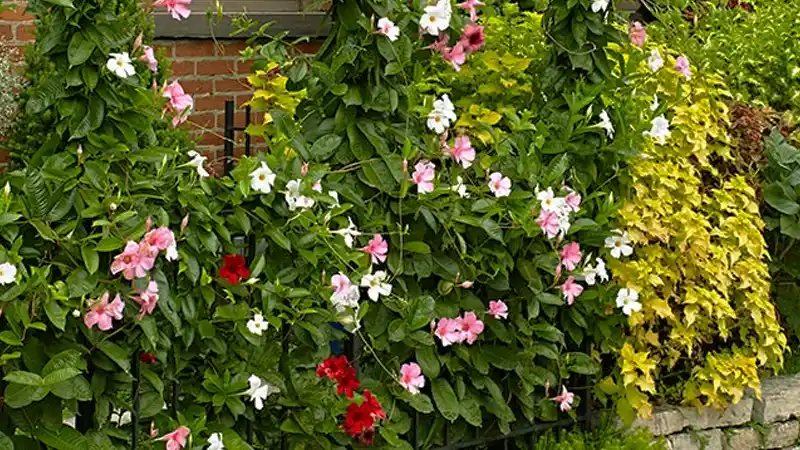
The Mandevilla plant, scientifically named Mandevilla Sanderi (Mandevilla spp.), is known for its trumpet-shaped tropical vine and evergreen glossy foliage.
Native to the Southwestern United States, Mexico, and Central America, this foliage mainly belongs to the species of flowering plant in the family Apocynaceae. Read the preceding paragraph to know other key elements related to this plant.
Overview of Mandevilla Plant
| Scientific Name | Mandevilla Sanderi (Mandevilla spp.) |
| Height | 3–10 ft. tall, 3–4 ft. wide |
| Growing Season | Spring or Summer |
| Plant Family | Apocynaceae |
| USDA Zone | 10-11 |
| Water Needs | Average |
| Sun Exposure | Medium to Bright sun exposure |
| Soil | Well-drained, Nutrient-rich soil |
| Origin | Rio de Janeiro, Brazil |
| Height | 3–10 ft. tall, 3–4 ft. wide |
| Flower Color | Abundant white, Electric pink, Deep red, Burgundy, yellow, or Apricot flowers |
| Spread | It can spread up to 3–20 feet (1-6 m) depending on growing conditions. |
Elementary Care and Maintenance of Mandevilla Plant
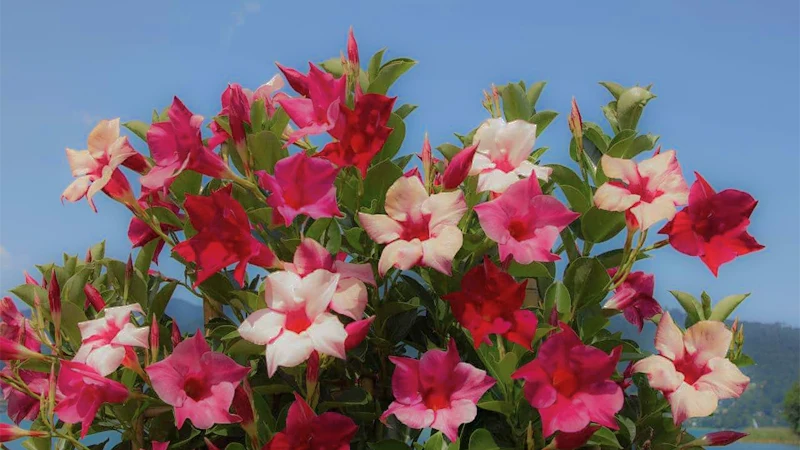
The most essential component of growing any plant is ensuring it receives a proportionate amount of water, soil, sun, temperature, and humidity. Each plant has its requirements; here is a complete guide and tips for maintaining the Mandevilla Plant.
1. Light
The most admirable trait of the Mandevilla plant is that it requires adequate sunlight to grow beautifully. In general, these plants need 6–8 hours of direct sunlight. They are primarily outdoor plants, but some Mandevilla vine plants can also be kept as indoor plants. A couple of them are White and Shining Mandevilla.
2. Soil
Mandevilla plants tend to grow fully and lushly in moist, well-drained soil. So, for healthy growth, plant it in well-moistured soil. Make sure to check the pH value of the soil; it should be between 6.0 and 7.5.
3. Water
These plants require a steady supply of soil moisture and water for sustained growth. Moreover, too much water can impact their lifespan, so water them carefully.
4. Temperature and Humidity
The environment required for its healthy growth is warm temperatures and high air humidity, which could be between 65 and 85 degrees Fahrenheit (29.44 °C). Furthermore, it grows excessively nutritiously in humid regions with temperatures around 60–70 degrees Fahrenheit.
5. Fertilizers
Mandevilla plants don’t require additional fertilizer, but liquid houseplant fertilizer can benefit them during the growing season.
Now that you’ve mastered the art of nurturing a beautiful Mandevilla plant, why not take a peek at the preceding section? You’ll find some wonderful tips on how to elevate your home’s charm with this elegant addition!
Ways to Incorporate Mandevilla Plant into Home for Elevating Aesthetics
Mandevilla plants immediately cheer up the room with their grace and bloom. They carry that energy and warmth to light up everyone’s mood and set the vibe.
There are numerous ways to incorporate the Mandevilla plant and turn your indoor and outdoor area into a perfect Pinteresty paradise. Below are a few suggestions; take a look and read!
- This plant is a showstopper, but pair it with Neon Pothos or Vine Plants for an extra artistically pleasing look. The dual elements of bright pink and lush green will enhance the view.
- Pairing different kinds of flowers together has long been a traditional practice. You can pair contrasting Hibiscus with Mandevilla to enhance the look, such as yellow Hibiscus and red Mandevilla Vine.
- Use hanging baskets to organize your balcony garden beautifully and give it a flowery vibe. For an eye-pleasing, soft aesthetic feel, you can put white and baby pink Mandevilla plants in the basket.
- No matter how tiny your balcony area is, personalize it to highlight its aesthetics. For example, you can put book stacks on one side and complement it with lots of Mandevilla plants on the other side.
Even though they look stunning, it’s important to choose the right one for your home! Take a moment to explore the next section and find the top five Mandevilla species that might be just right for you.
Top 5 Species of Mandevilla Vine Recommended by Botanists
Now that you know how Mandevilla plants can enhance your style and add a splash of cheerfulness, it’s time to find out which one complements your home layout! Below are the five best Mandevilla vine plants recommended by botanists!
1. Chilean Jasmine Mandevilla
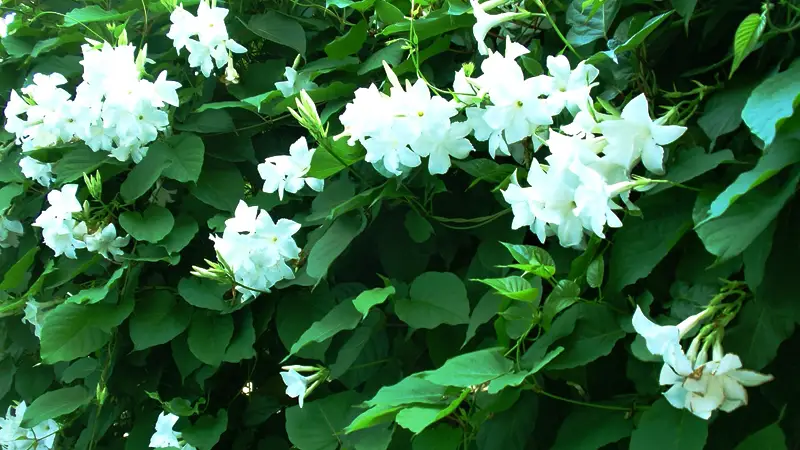
Chilean Jasmine, scientifically known as Mandevilla laxa, is an evergreen outdoor plant with white flowers and foliage that typically grows up to 20 feet (6.1 meters) in height. It grows exceptionally beautifully in moist, well-drained soil with average humidity.
| Scientific Name | Mandevilla laxa |
| USDA Growing Zone | 11-12 |
| Sun Exposure | Partial |
| Soil | Acidic |
| Plant Size | 6-8 ft |
2. Brazilian Jasmine Mandevilla
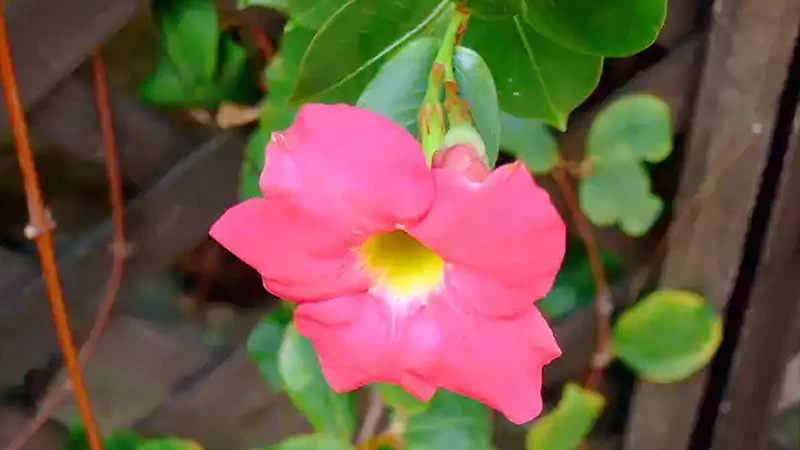
As the name suggests, this plant is stunning and often used as a decorative outdoor plant due to its slushy pinkish-red flowers and woody stems. It prefers bright, indirect light and well-drained soil.
| Scientific Name | Mandevilla Bolivians |
| USDA Growing Zone | 10-11 |
| Sun Exposure | Partial |
| Soil | Well-drained |
| Plant Size | 6-9 ft |
3. Alice du Pont Mandevilla
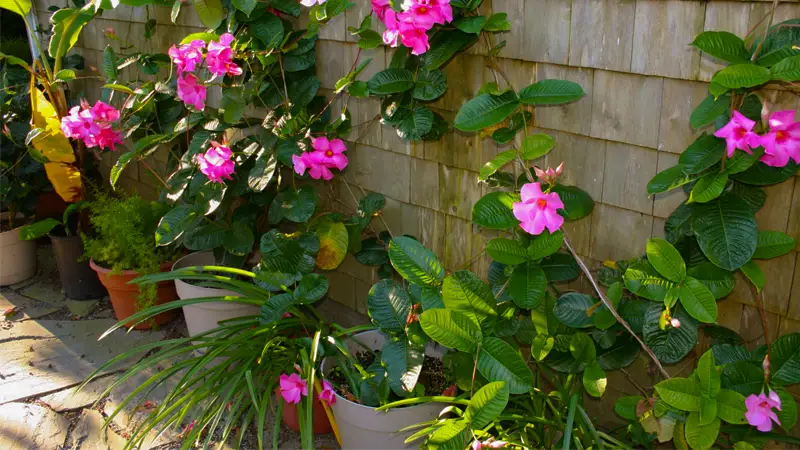
Alice du Pont Mandevilla is an excellent choice for hanging baskets because of its attractive leaves. Its flowers are pink trumpet-shaped, with contrasting oval, dark green, and glossy leaves.
| Scientific Name | Mandevilla sanderi |
| USDA Growing Zone | 10-11 |
| Sun Exposure | Full Sun |
| Soil | Moist Soil |
| Plant Size | 7-8 ft |
4. Shining Mandevilla
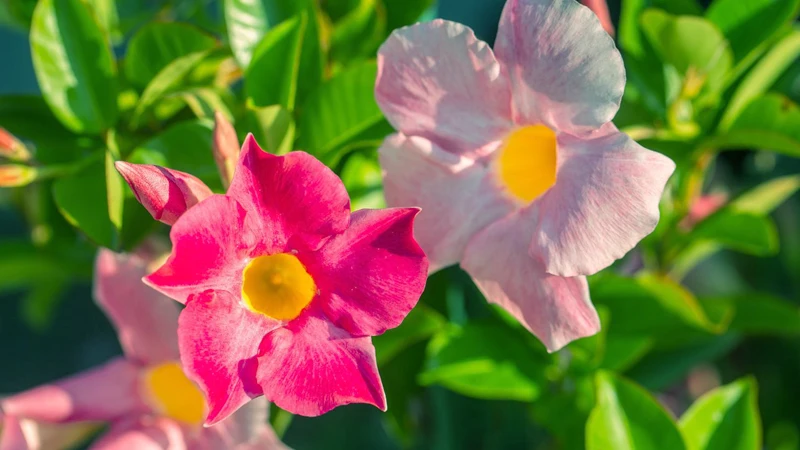
The Shining Mandevilla is a tropical flowering plant with narrow leaves that requires sunlight for 7–8 hours to give it a pink flowering plant!! Additionally, regular cleaning helps maintain its shape and encourages its longevity.
| Scientific Name | Mandevilla x amabilis |
| USDA Growing Zone | 10-12 |
| Sun Exposure | Partial Sun |
| Soil | Well Drained |
| Plant Size | 7-8 ft |
5. White Mandevilla
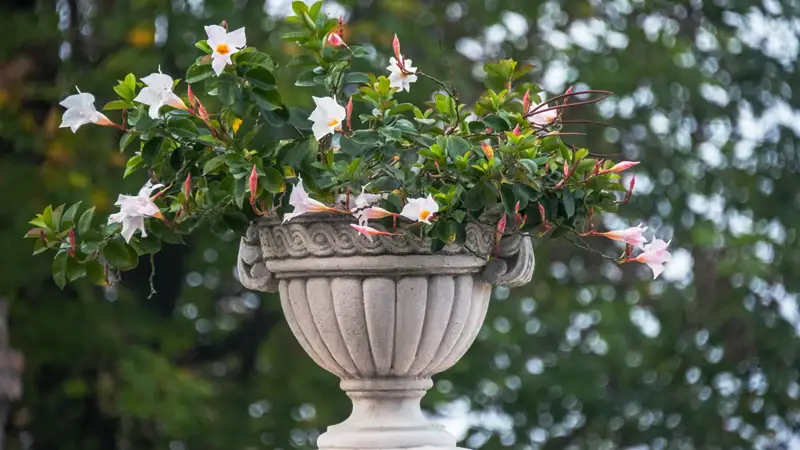
This plant is another variant of the Mandevilla. It has beautiful variegated leaves and flowers in green and white patterns. Regular misting can help maintain humidity levels and encourage its longevity.
| Scientific Name | Mandevilla boliviensis |
| USDA Growing Zone | 9-10 |
| Sun Exposure | Partial Sun |
| Soil | Well Drained |
| Plant Size | 7-8 ft |
Propagating Methods of Mandevilla Vine (Complete Guide)
Propagating plants demonstrates our care for these beauties and also promotes their longevity. Though Mandevilla vine seems to be an easy-going plant with minimal care, on the flip side, their propagating method varies from plant to plant.
Hence, the most common approaches that individuals widely use are the seed approach and the parent plant technique.
1. By Parent Plant
If you look forward to propagating it from the parent plant, follow the procedure below.
- Start by sterilizing your tools and grab a pot.
- Remove extra fledgling leaves from the stem’s base.
- Prepare a well-draining potting mix (medium moist soil is preferred).
- Pot the new plant, extracted from the parent plant, into well-moist soil and add the required fertilizers.
- Try to keep it near a warm area.
2. Through Seeds
To propagate from the seeds, carefully follow the steps outlined below.
- Take fresh seeds and let them dry first.
- Harvest the seeds and soak them overnight.
- Sterilizing your tools the following day.
- Grab a pot; prepare a well-draining potting mix.
- Place the seeds and water them regularly.
How to Winter Over Mandevilla?
Mandevilla plants are tropical and can’t stand freezing cold. So, in winter, move your plant indoors to a bright, airy space before the frost hits. Remember that for a healthy plant, the temperature should be around 50 degrees, and the plant should receive at least 4 to 6 hours of sunlight daily.
Common Problems You Might Face While Handling Mandevilla Vine Plant
Every plant is different, and so are its maintenance and care! By now, you should know enough about the Mandevilla Vine.
Another important component is learning about the common issues that one might face while caring for a Mandevilla plant. Below are a few of them, so take the time to read them.
- Mandevilla Plant shows various signs of unhealthy parenting. One of them is overwatering, which causes the leaves to turn yellow. On the flip side, if its leaves or flowers drop by, this can be major because of under-watering.
- Plants are vulnerable to fungal diseases during humid weather; changing the color of the leaves is a common sign for the same.
- Mandevilla plants are also sensitive to viruses and diseases, so to protect them from infections and unhealthy growth, you must prune the affected areas, trash them, and disinfect your tools.
- The Mandevilla vine plants attract pests and insects, so inspect them regularly. Additionally, you can prepare a Neem-based essential oil to repel pests.
Warning ❗
The Mandevilla plant is slightly poisonous, so keep it away from pets and children and wear gloves when handling it.
Wrapping Up!
Mandevilla plants enhance your outdoor area with their colorful flowers and lively atmosphere. One of the most significant advantages is their versatility; you can combine them with other plants for an even more eye-catching display.
Utilize the information provided to cultivate and care for a thriving Mandevilla plant. These beautiful plants will transform your outdoor area, infusing it with joy. Furthermore, following the tips above, you can seamlessly incorporate them into your home and achieve a perfect ‘so pretty’ vibe!!
Can you grow Mandevilla plants indoors?
Yes, you can grow Mandevilla plants indoors, but their flowers typically bloom more beautifully outdoors.
How much sunlight does it need on average?
As we mentioned, it is an outdoor plant that requires 6–7 hours of direct sunlight to grow fruitfully.
What temperature do Mandevilla Plants require?
These plants grow further in humid and warm regions, so the appropriate temperature is around 30 C.
Mandevilla, by Wikipedia

